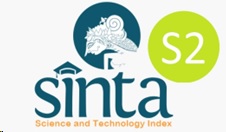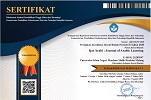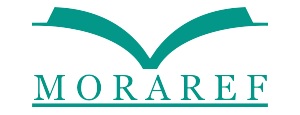Nationalism Values In Arabic Textbooks: An Analysis Of Indonesian Ministry Of Religious Affairs-Endorsed Arabic Textbooks
Abstract
Keywords
Full Text:
PDFReferences
Afrina, A., Abbas, E. W., & Susanto, H. (2021). The Role of Historical Science in Social Studies Learning Materials for Increasing Values of Student’s Nationalism. The Innovation of Social Studies Journal, 3(1), 1. https://doi.org/10.20527/iis.v3i1.3769
Alzubi, A. A. F., Al-Mwzaiji, K. N. A., & Nazim, M. (2023). Representation of national identity and culture in the Saudi EFL textbook series mega goal: A critical discourse analysis. International Journal of Learning, Teaching and Educational Research. https://doi.org/10.26803/ijlter.22.6.30
Apriani, A. N., & Ariyani, Y. D. (2017). Implementasi pendidikan nilai nasionalisme dalam pembelajaran living values. LITERASI (Jurnal Ilmu Pendidikan).
Ariyani, Y. D., & Apriani, A. (2017). Analisis Muatan Nilai-nilai Nasionalisme Pada Buku Teks KTSP PKn Kelas 3 SD. Elementary School, 4, 171–181.
Braun, V., & Clarke, V. (2006). Using thematic analysis in psychology. Qualitative Research in Psychology, 3(2). https://doi.org/10.1191/1478088706QP063OA
Brugeilles, C., & Cromer, S. (2009). Promoting gender equality through textbooks: A methodological guide. repository.gei.de.
Carney, R. N., & Levin, J. R. (2002). Pictorial illustrations still improve students’ learning from text. Educational Psychology Review, 14(1), 5–26. https://doi.org/10.1023/A:1013176309260
Carrier, P. (2018). The Nation, Nationhood, and Nationalism in Textbook Research from 1951 to 2017. The Palgrave Handbook of Textbook Studies, 181–198. https://doi.org/10.1057/978-1-137-53142-1_13
Craeynest, F. Van. (2015). Gender representations in EFL textbooks: A quantitative and qualitative content analysis. Unpublished Master’s Thesis. Ghent University.
Curdt-Christiansen, X. L. (2017). Language Socialization Through Textbooks. In P. A. Duff & S. May (Eds.), Language Socialization (pp. 1–16). Springer International Publishing. https://doi.org/10.1007/978-3-319-02327-4_15-1
Cutting, J. E., & Massironi, M. (1998). Pictures and their special status in perceptual and cognitive inquiry. In Perception and cognition at century’s end: History, philosophy, and theory. Academic Press, San Diego, CA. books.google.com.
Dahliyana, A., Budimansyah, D., Nurdin, E. S., & Suryadi, A. (2021). The challenges of civic and moral educations for young muslim Indonesian. International Journal of Early Childhood Special Education. https://doi.org/10.9756/INT-JECSE/V13I2.211073
Dejene, W. (2017). A survey of gender representation in Social Studies Textbooks of Ethiopian primary schools. British Journal of Education, Society & Behavioural Science, 21(1), 1–7.
Ersoy, & Figen, A. (2013). An analysis of social studies textbooks in Turkey: From national citizenship to global citizenship. International Journal of Progressive Education, 9(3), 137–153.
Evagorou, M., Erduran, S., & Mäntylä, T. (2015). The role of visual representations in scientific practices: From conceptual understanding and knowledge generation to ‘seeing’ how science works. International Journal of STEM Education, 2, 1–13. https://doi.org/10.1186/S40594-015-0024-X
Garzone, G. E., Paganoni, M. C., Reisigl, M., Maci, S. M., Turnbull, J., Mattiello, E., & Heaney, D. B. (2021). Religion, Ideology, and Nation-building in Jordanian Textbooks and Curricula for the Teaching of Arabic Language Nijmi. Languages Cultures Mediation, 8(2), 81–100.
Ge, Y. P., Unsworth, L., Wang, K. H., & Chang, H. P. (2018). What images reveal: A comparative study of science images between Australian and Taiwanese junior high school textbooks. Research in Science Education. https://doi.org/10.1007/s11165-016-9608-9
Geertz, C. (1992). Local Knowledge" and Its Limits: Some" Obiter Dicta. The Yale Journal of Criticism.
Jain, H. (2023). Nationalism and education. https://prepwithharshita.com/nationalism-and-education/
Kartodirdjo, S. (1999). Multidimensi pembangunan bangsa: Etos Nasionalisme dan Negara kesatuan. Penerbit Kanisius.
Kuraedah, S., Gunawan, F., Alam, S., & Ubaidillah, M. F. (2022). Cultural representation in English and Arabic textbooks endorsed by Indonesian government: What do textbooks tell us about? Journal of Social Studies Education Research, 13(3), 229–255.
Kuraedah, S., Gunawan, F., Alam, S., Ubaidillah, M. F., Alimin, A., & Fitriyani, F. (2023). Gender representation in government-endorsed Arabic language textbooks: Insights from Indonesia. Frontiers in Education, 7(January), 1–14. https://doi.org/10.3389/feduc.2022.1022998
Ḵūwayrī, Y. M. (2000). Arab Nationalism: A History: Nation and State in the Arab World. Blackwell.
Lee, D. (2010). Portrayals of non-North Koreans in North Korean textbooks and the formation of national identity. Asian Studies Review. https://doi.org/10.1080/10357823.2010.507865
Lee, D. B., & Wang, Q. (2023). Portrayal of the national identity in Chinese language textbooks. Journal of Curriculum Studies. https://doi.org/10.1080/00220272.2023.2181672
Lestari, S. U., Saraswati, U., & Muntolib, A. (2018). Penanaman nilai-nilai nasionalisme dalam pembelajaran sejarah di SMA Negeri 2 Wates, Kulon Progo. ISTORIA: Jurnal Pendidikan Dan Ilmu Sejarah, 13(2), 205–215. https://doi.org/10.21831/istoria.v13i2.17736
Lewicka, M., & Waszau, A. (2017). Analysis of Textbooks for Teaching Arabic as a Foreign Language in terms of the Cultural Curriculum. Universal Journal of Educational Research, 5(1), 36–44. https://doi.org/10.13189/ujer.2017.050105
Listyarti, R. (2007). Pendidikan Kewarganegaraan.
Masita, E. (2021). The representation of Indonesian national identity in English textbook. Indonesian Research Journal in Education. https://doi.org/10.22437/irje.v5i1.10599
McConachy, T., & Hata, K. (2013). Addressing textbook representations of pragmatics and culture. ELT Journal, 67(3), 294–301.
McDonough, K., & Cormier, A. A. (2013). Beyond patriotic education: Locating the place of nationalism in the public school curriculum. Education, Citizenship and Social Justice, 8(2), 135–150. https://doi.org/10.1177/1746197913483657
Moesa, A. M. (2007). Nasionalisme Kiai; Konstruksi Sosial Berbasis Agama. books.google.com.
Muhtarom, T. (2020). The comparison of nationalism and civic education value between indonesian and malaysian elementary school textbook. Elementary Education Online, 19(3), 1185–1199. https://doi.org/10.17051/ilkonline.2020.728015
Nairn, T., & James, P. (2005). Global matrix: Nationalism, globalism and state-terrorism. researchdirect.westernsydney.edu ….
Negedu, I. A., & Ojomah, S. O. (2021). Intercultural communication in the wake of globalism. Intercultural Education, 32(6), 667–681. https://doi.org/10.1080/14675986.2021.1985805
Nuruddin, N., Budiaman, B., Ilham, A., & Haqi, A. M. (2021). The Need for Arabic Language Teaching Materials Based on Multicultural Education for Indonesian Diaspora Students. Alsinatuna, 7(1), 45–63.
Rahman, A., & Nurhuda, A. (2022). “ Al-’Arabiyyatu Baina Yadaik”: Textbook by Abdul Rahman ibn Ibrahim Al-Fawzan, Etc. SUKMA: JURNAL PENDIDIKAN, 6(1), 1–16.
Rahmawati, I. Y. (2017). Keterbacaan Buku Bahasa Indonesia (Studi Kasus Buku “Ekspresi Diri dan Akademik” Untuk Kelas X SMA Kurikulum 2013). Jurnal Dimensi Pendidikan Dan Pembelajaran.
Reynolds, J. C. (1981). Textbooks: Guardians of Nationalism. Education, 102(1).
Saputra, B. D., Murdiono, M., & Tohani, E. (2023). Nationalism education in elementary school: A systematic literature review. International Journal of Evaluation and Research in Education (IJERE). https://doi.org/10.11591/ijere.v12i2.24609
Smith, A. D. (2013). Nationalism: Theory, ideology, history. books.google.com.
Soleimani, K., & Osmanzadeh, D. (2022). Textualising the ethno-religious sovereign, history, ethnicity and nationalism in the Perso-Islamic textbooks. Nations and Nationalism, 28(3), 1022–1039. https://doi.org/10.1111/nana.12705
Taylor-Mendes, C. (2009). Construction of racial stereotypes in English as a foreign language (EFL) textbooks: Images as discourse. Race, Culture, and Identities in Second Language Education.
Tröhler, D. (2020). National literacies, or modern education and the art of fabricating national minds. Journal of Curriculum Studies, 52(5), 620–635. https://doi.org/10.1080/00220272.2020.1786727
Vasilijević, D., Semiz, M., & Adžić, B. (2021). National identity in the textbooks of English as a foreign language. Zbornik Radova Filozofskog Fakulteta u Pristini. https://doi.org/10.5937/zrffp51-32180
Widodo, H. P. (2015). The development of vocational English materials from a social semiotic perspective: Participatory action research. digital.library.adelaide.edu.au.
Widodo, H. P. (2018). A critical micro-semiotic analysis of values depicted in the Indonesian Ministry of National Education-endorsed secondary school English textbook. Situating Moral and Cultural Values in ELT Materials: The Southeast Asian Context. https://doi.org/10.1007/978-3-319-63677-1_8
Yasar, O., & Seremet, M. (2007). A comparative analysis regarding pictures included in secondary school geography textbooks taught in Turkey. International Research in Geographical & Environmental Education, 16(2), 157–188. https://doi.org/10.2167/irgee216.0
Zembylas, M. (2022). Conceptualizing and studying “affective nationalism” in education: Theoretical and methodological considerations. Race Ethnicity and Education. https://doi.org/10.1080/13613324.2021.1969904
DOI: https://doi.org/10.18860/ijazarabi.v8i1.28993
Refbacks
- There are currently no refbacks.
Copyright (c) 2025 Muhamad Jaeni, M. Ali Ghufron, Muassomah Muassomah
License URL: https://creativecommons.org/licenses/by-sa/4.0/












